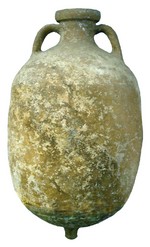Roman Amphorae: a digital resource
University of Southampton, 2005. (updated 2014) https://doi.org/10.5284/1028192. How to cite using this DOI
Data copyright © University of Southampton unless otherwise stated
This work is licensed under the ADS Terms of Use and Access.
Primary contact
Dr
David
Williams
Dept of Archaeology
University of Southampton
Avenue Campus
Highfield
Southampton
SO17 1BJ
England
Tel: 080 593032
Resource identifiers
- ADS Collection: 463
- DOI:https://doi.org/10.5284/1028192
- How to cite using this DOI
Oberaden 83

Courtesy of Museo Nacional de Arqueología Maritima, Cartagena
David Williams
Distinctive FeaturesThe antecedent of the Dressel 20 but with an ovoid body, thinner handles and a fairly well developed spike. The rim is rounded, sometimes with an internal concavity (Berni, 1998).See characteristics | ||
Date RangeAugustan period. The earliest date is around: 15-9 BC (Aislingen, Oberaden). The precise point of transition to the Dressel 20 is difficult to discern, but the latter predominates from the AD 14 onwards according to the morphological study by Berni (1998) , see under 'Drawings' . Latest date is in the Tiberian period (Haltern, Köln, Trier)Search: [1st century BC] [1st century AD] | ||
OriginAs this form is related to Dressel 20 and is found in a closely similar fabric, it almost certainly originated along the Guadalquivir between Seville and Córdoba.Search: [North West Europe] [Spain] [Western Mediterranean] | ||
DistributionCommonly encountered in forts of the German limes such as Augst, Vindonissa, Oberaden, Haltern, Trier and Lorenzberg (Berni, 1998). Also found in pre-Roman contexts in Britain (Williams & Peacock, 1983) and at Rome.Search: [Germany] [Great Britain] [Italy] [North West Europe] [Spain] [Switzerland] [Western Mediterranean] | ||
ContentsOlive oil.Search: [Olive Oil] | ||
CommentsPrincipal contributor: César Carreras | ||
ClassificationDressel 25Haltern 71 Peacock & Williams 24 | ||
CEIPAC linkThe following link will take you to the Centro para el Estudio de la Interdependencia Provincial en la Antiguedad Clásica CEIPAC database. In the CEIPAC system this amphora has the ID KE51+BYZ. Note: access to CEIPAC requires registration, which is possible via http://ceipac.ub.edu/corpus_reg.php?IDM=e | ||



 3D models
3D models


